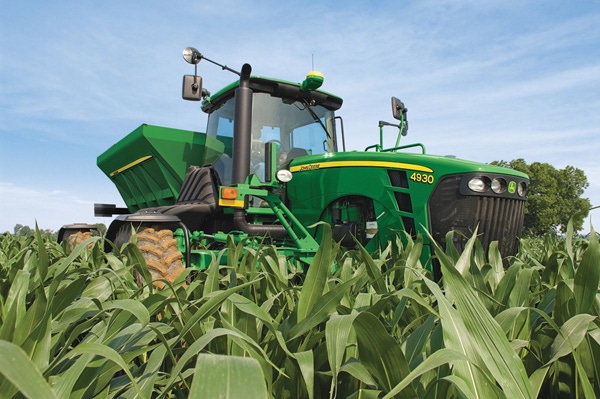
Time was — and not too long ago — the dashboard of a farm pickup often doubled as a filing cabinet for receipts, notebooks, spray schedules, and a mishmash of other documents, usually secured with a rubber band, sometimes stuck in a shoebox, but never completely organized.
Farmers just seemed to know which pile contained fertilizer rates, which included planting dates, and what bundle contained the feed bill due by the end of the week. It wasn’t an elaborate system, but for some folks, in a simpler time, it worked.
Not today. Information has become coin of the realm for most farm operations. All those stacks and bundles of unorganized data can be stored and accessed on a smart phone and transmitted from that palm-sized gadget to computers on board farm equipment and in the farm office.
Access to all that information is an essential part of managing a 21st century farm.
Learning how to use that data effectively may be key to increasing productivity to meet the world’s rapidly expanding demand for food and fiber, says Matt Waits, CEO of SST Technology, Stillwater, Okla., who spoke at the recent Oklahoma State University Rural Economic Outlook Conference at Stillwater.
Help solve challenges
SST’s mission, he says, is to help farmers solve the many challenges they face, one of which is to improve agricultural output to match population growth. That means doubling corn yields from 160 bushels per acre to 300 bushels and wheat from 45 bushels to 90 bushels. “I think we can do that,” he says.
History backs him up. Corn yields in the 1920s averaged 20 bushels per acre. By the 1940s they had doubled; by the 1980s they had doubled again, and today they’re pushing 160 bushels per acre. “We have tripled production three times in the last 100 years,” Waits says. “We will be asked to do that again — and we can.”
Past yield bumps came from improved technology, better varieties, improved farm management, mechanization, and most recently, genetic engineering. But agriculture will need even more to reach 300 bushel per acre corn yields, he says. “Now, farmers need information. They are changing from basing decisions on gut feelings, or historical knowledge, to analyzing data and using computer models accessible to and usable by non-experts.”
The key initially will be gathering information from the field — information on planting, spraying, materials, yields, in-season imagery, soil types, weather, and other practices will be integrated into what Waits describes as “lagoons of data.”
Improve production, profits
Armed with that information, farmers or consultants can identify field needs and tweak systems to improve efficiency. Variable rate fertilization, “already routinely practiced in the Midwest,” is one example of putting data to good use, he says.
SST Technology uses a client’s own data to improve production and profitability, Waits says. “Farmers can send soil samples to the Oklahoma State University lab and have results sent to our service.” SST can then develop maps and provide recommendations for fields and specific areas within fields.
“We may not recommend less fertilizer, but we will recommend that farmers apply fertilizer where it’s needed. We also see environmental benefits by not applying fertilizer and other products where they’re not needed.”
The data can be transferred wirelessly to and from field equipment. Remote sensing is part of the process. “We identify problem areas in the field, and we identify locations to check and monitor. Yield data allows us to create yield maps, and from those we create automated seeding recommendations based on multiple years of data.
“We can see which areas are not performing, and can adjust seeding and other input rates to maximize production.”
With adequate data and the ability to analyze and use the data, farmers can take advantage of “profit mapping,” as they collect enough data to identify which areas of the field are making money. “They can then back off inputs on parts of a field that are weak. They may even find it best to take fields out of production and idle the land.”
Bigger possibilities
SST customers’ profits have outperformed average by 22 percent, Wait says. “We’re just at the beginning of information analysis — we see bigger possibilities with Big Data by using information pulled from wider data sets.”
So far, he says, farmers have used information from a relatively small information bank, mostly farm criteria. “But agriculture is more complex; we have many more corn hybrids now than we did just a few years ago. On-farm tests are less valuable — by the time a farmer gets useful results, the product may no longer be available. We need a wider data set, and we need to share data. That’s the future of agriculture decision-making.”
Farmers need systems that will evaluate products, climates, and agronomic models and change the way they make decisions, Waits says. “That’s where we’re going: looking at past and present data and predicting needs.” A wider data set allows farmers to receive more information over a mobile device and “operate their businesses on smart phones.”
Challenges ahead
Building a management system around a complex data collection and dispersal system comes with significant challenges, Waits says. “Farmers know how to do fieldwork; they understand soil fertility, yield maps, and such. But they struggle to put it all together. They now need to collect data and move it into a system. But they have to be assured that their data is safe.”
A single company providing all the necessary data may seem ideal, he says, but may not be feasible. “I don’t think that would work, because it requires too many areas of expertise, and we have too many systems.” A company would need experts for soils, varieties, and fertility, for example. Farmers also have on-board equipment, possibly from several suppliers, and systems from different equipment manufacturers that might not mesh.
“We need software programs that talk to each other and share data back and forth,” Waits says. “We have too many systems, too many service providers, and bits of data scattered all over. SST is working on synchronization instead of a central place where all data exists. But the grower must be in control of his data — he is the one who chooses what he shares and who he shares it with. We’ve been working on this for a long time. We secure the data for the farmer.”
The ability to collect, analyze, and use information will allow farmers to improve decision-making and increase yields, Waits says.
It will also keep pickup dashboards a lot less cluttered.
About the Author(s)
You May Also Like






